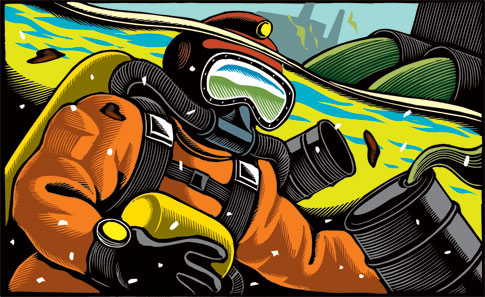DPlan - Model
D-Plan has a wide array of decompression models to choose from. All models run within the same neo-Haldanian framework.
Buehlmann's 1990 ZH-L16B model is designed for pre-dive planning and is the most widely used decompression model in the world. The ZH-L16C version is designed for real-time use in dive computers and is slightly more conservative.
ZH-L12C and ZH-L8C are ZH-L16C with either the 4 or 8 longest compartments omitted, as is commonly done in (older?) recreational dive computers. This has little or no effect on recreational dive profiles but has a very real effect on technical and saturation dive profiles. This points out why you should not push your equipment beyond its designed uses, or trust your dive computer too much, as you really don't know exactly what it is calculating! Note that none of the ZH-L models are today considered adequate without additional conservatism factors.
A number of other decompression models are listed here, not because they are suitable for real-world use, but are of historic interest:
The 1983 ZH-L12 model is an earlier version based entirely empirical observations. It is more conservative than the later ZH-L16 models and excessively conservative with regard to helium.
Workman's 1965 model is the earliest of all the modern decompression models presented here. Despite its age, Workman's model produces similar results to Buehlmann's later models, even for helium mixes.
The following models are incomplete and/or possibly wrong, or simply should not be used:
The ZH-L16A version of Buehlmann's algorithm was the prototype for the other two and is not considered safe for real use, despite the fact that the differences between all three of Buehlmann's models are negligible once they are chopped up into a stepped decompression schedule.
Haldane's original 1908 model is the earliest of all decompression models. It is based on five tissue compartments: 5-10-20-40-75 and a constant allowable over-pressure. By default, the model here uses a dangerously high value of 2.0. Use the MaxPR factor to throttle it back to Haldane's final 1.58, or any value you would like to try. At 1.58, Haldane's model turns out surprisingly conservative results for short dives, despite the fact that it is not considered safe for real use. For long exposures, this becomes quite clear. If Haldane had simply included longer tissue compartments, his model would have been much more realistic. The second Haldane option explores this possibility, with extended tissue compartments and a reduced pressure ratio of 1.58.
The US Navy model of 1955 is interesting for the short and risky schedules it produces - even shorter than their dive tables ( which have clearly been tweaked in the most dangerous cases. ) The first Navy option is purely mathematical, while the second is based on empirical data.
My DCAP model is incomplete. At present, I am missing the helium compartment half-times and other details of the algorithm. For the moment, the missing information has been estimated, and I have assumed that DCAP uses the same basic algorithm as Buehlmann and the rest. DCAP has a much greater level of conservatism built into it than any of the other models, for example, automatically generating deep stops for all dive profiles. Therefore, all conservatism factors are disabled with DCAP. The first DCAP option treats helium as slow - the same as Nitrogen. The second DCAP option treats it as fast, as with Buehlmann. The first option appears to be more correct, but results for helium mixes should not be trusted. I really want to get this working.
Both of my DSAT models are completely experimental implementations. They sometimes agree surprisingly well with the PADI RDP, sometimes not. The DSAT algorithm is strictly no-decompression, and somewhat different from the rest, requiring some special-casing in the code. During surface intervals, the DSAT model estimates off-gassing using only the 60-minute compartment. ( This is probably done to account for the short/shallow safety stops they encourage you to take. ) This is not implemented in D-Plan, and there may be other differences as well. Conservatism factors are disabled with DSAT. The first DSAT option uses 7 tissue compartments, the second uses 14.

